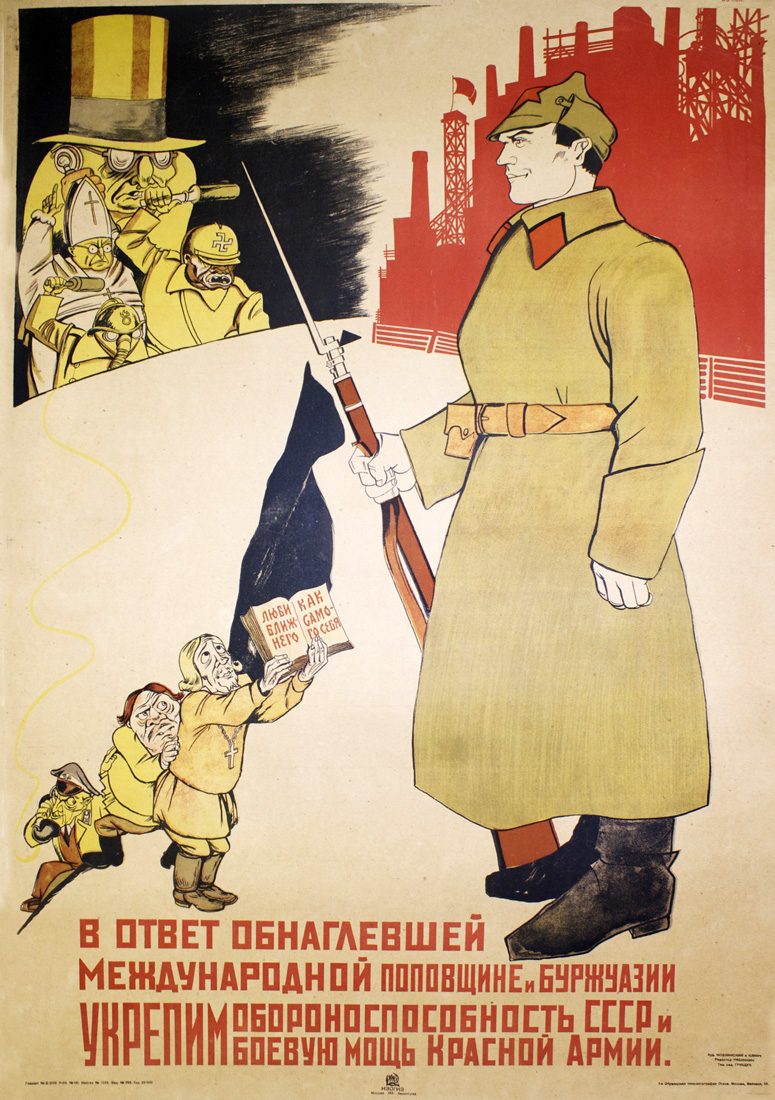
As an answer to international papists and bourgeoisie, we will strengthen the defensive ability of the USSR and the fighting power of the Red Army!
Poster Number: PP 337
Category: Military
Poster Notes: (Written on the book shown to the soldier) ‘Love your Neighbor like Yourself.’
Media Size: 45.5x32
Poster Type: Lithograph
Publishing Date: 1931
Editorial Information: Editor Riabinkin; Technical Editor Grishchuk
Technical Information on Poster: Izogiz No. 1234; R-33; No. 181; Order No. 755; [Printed at] 28 Valovaia Street
Print Run: 20,000
Glavlit Directory Number: B-2109
Catalog Notes: PP 337 Military
Artist: Kozlinskii, Vladimir Ivanovich — Козлинский, Владимир Иванович
Vladimir Ivanovich Kozlinskii was one of Vladimir Mayakovskii’s artistic collaborators and he was the head artist of the Petrograd ROSTA (Russian Telegraph Agency) Studio. Reportedly, Kozlinskii was born at Kronstadt naval base on Kotlin Island just west of St. Petersburg. His artistic endeavors began when he attended the Drawing School of the Society for the Encouragement of Arts, enrolling in 1907. In addition to studying art under a number of private instructors, in 1911, Kozlinskii enrolled in...
Read More About This Artist
Artist: Klinch, Boris Grigor'evich (Petrushanskii, Garri) — Клинч, Борис Григорьевич (Петрушанский, Гарри)
Boris Grigor'evich Klinch was a Soviet graphic artist, cartoonist and illustrator who lived and worked in Moscow. His professional career began during the 1920s. Klinch took-on the pseudonyms “Garri” (Harry) and “Petrushanskii”, when he signed his work. The artist was published in major Soviet humorist periodicals during the 1920s and 1930s, including Krokodil [Crocodile], Krasnyi perets [Red Pepper], and Frontovoi iumor [Humor for the Front]. Klinch began participating in exhibitions in 1921. In 1938 for example,...
Read More About This Artist
Printer: 1st Exemplary Ogiz RSFSR Typography Workshop of the Poligrafkniga Trust, Moscow — 1-я Образцовая типография Огиза РСФСР треста Полиграфкнига, Москва
1st Exemplary Ogiz RSFSR Typography Workshop of the Poligrafkniga Trust was located in Moscow at 28 Valovaia Street. Historically, the workshop began as the Sharapov-Sytin Partnerhip in the era prior to the Russian Revolution. Ivan Dmitrievich Sytin (1851-1934) was the son of a peasant. He opened a small print shop in Moscow using a single press and by the start of the 20th century his printing business (at Valovaia and Piatnitskaia streets) was the largest private ...
Read More About This Printer
Publisher: IzoGiz (State Publishing House of Fine Art), Moscow-Leningrad — Изогиз (Государственное издательство изобразительного искусства), Москва-Ленинград
The history of IzoGiz begins with the formation of Ogiz, the Association of the State Book and Magazine Publishers. In 1930, the Sovnarkom of the Russian Socialist Federative Soviet Republic established Ogiz to centralize publishing under a monopoly in order to eliminate duplication of printed material, to streamline and control publishing production and its output, and to create a base for marketing books, training and technical manuals. In 1931, the Central Committee of the USSR ordered certain ...
Read More About This Publisher